Sri Lanka is the beautiful emerald teardrop that falls from the southern shore of India. Called Ceylon until 1972, in modern history the island has been internationally known for tea, a civil war, and the sport of cricket, but is also home to a lavish array of wildlife.
There are 22 National Parks on the island, of which Yala is the second largest at 97,880.7 hectares (377.919 sq. mi), and the most visited. Situated in the south east corner of Sri Lanka, Yala was designated a National Park in 1938 and has since become important in the fight for conservation of the Asian Elephant.
As part of a journey through Sri Lanka, we stayed at a campsite within the National Park for 2 nights. The operation was run by Kulu Safaris. It is a luxury version of camping, where tents were comfortable and, as with everywhere we visited in Sri Lanka, evening meals by the lake were exquisite. We could have saved money by staying outside the park, but with only 2 nights available, we wanted to buy time in the park. What price do I place on falling asleep to a chorus of frogs singing and crickets chirping?
Yala is a treasure trove of wildlife. The park has become famous for her leopards and elephants, but we were treated to a stage where exquisite birds, mammals and reptiles performed from dawn ‘til dusk and deep in to the night.
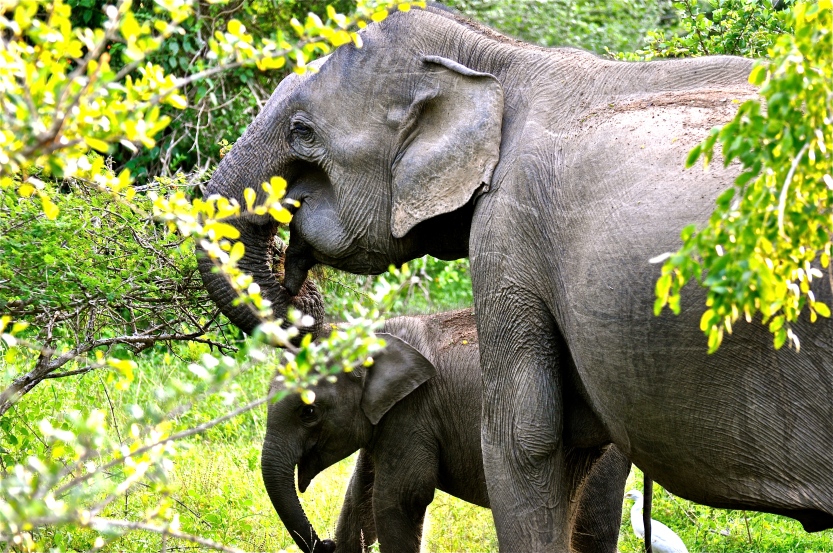
Our first elephant sighting was a mother and baby, feeding amongst bushes. This was my first ever sighting of the endangered, wild Asian elephants of the subcontinent. There are few sights in the animal kingdom as endearing as the sight of a baby elephant. I challenge anyone not to smile at these playful, oddly put together, fuzzy little creatures. The baby is in stark contrast to the magnificent, furrowed matriarch that is its mother.
The Sri Lankan elephant is the largest of the Asian species and also the darkest, but maintains the familiar pink pigment of the skin around the ears and face.
Some distant sightings of the herd followed, before we chanced upon a large and aggressive Tusker on the road side. We stopped, and he stopped. Grumbling and growling he stood before us in all his magnificence. As if he didn’t already cut an intimidating figure, he proceeded to use his mighty trunk to blast clouds of amber dust in to the air, in a display designed to remind us that he is the king of these lands. We did not disagree!
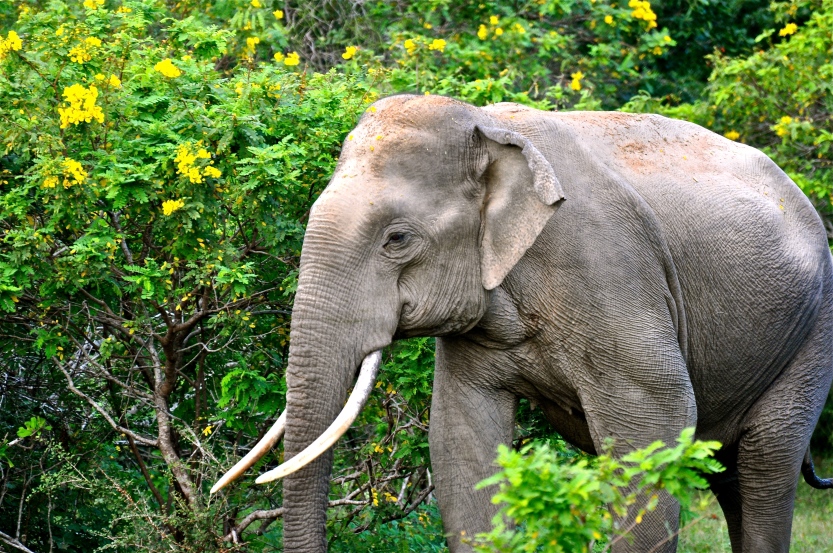
The next elephant to make our acquaintance was also a mighty male who bulldozed through the bushes, stepping on to the track in front of us. There were no histrionics from this behemoth, but his imposing presence was awe inspiring, as he swaggered alongside our jeep. Our cameras were clicking, beeping and buzzing when a deep, rich amber eye, contemplated us from an arm’s reach away. He paused for a closer inspection, and a surge of adrenaline griped me, freezing my fingers and catching my breath. I didn’t dare to move, as this may have broken the magic of the moment or worse still, may have upset all 10 tons of this colossus. For a while, the only sound I could hear was my heartbeat, which seemed to be thumping out a rhythm on my eardrum. Known for their ability to hear sounds well below the human range, surely he could hear this excited thud, too.

He rumbled a deep, long groan of indifference before continuing his amble along the track, stopping for an occasional snack on some bushes, as we followed at a respectful distance.
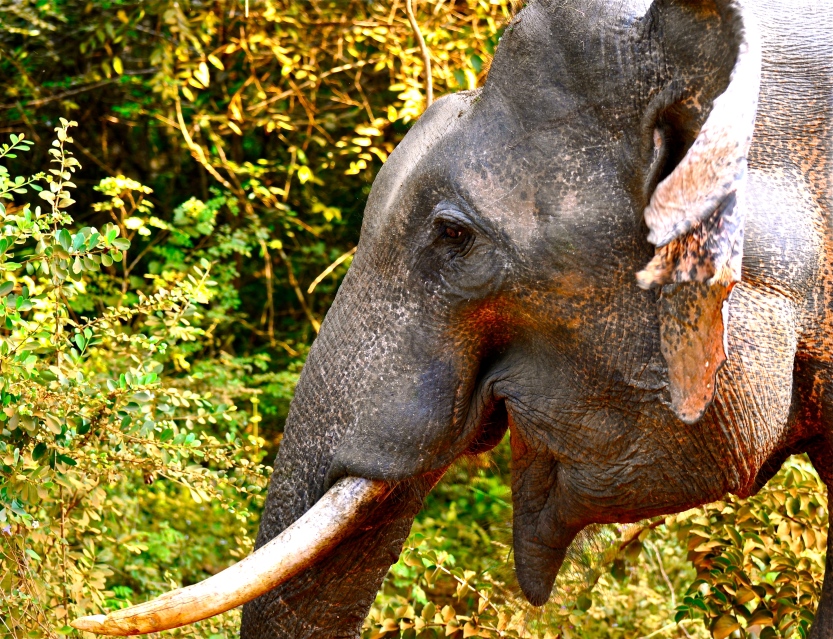
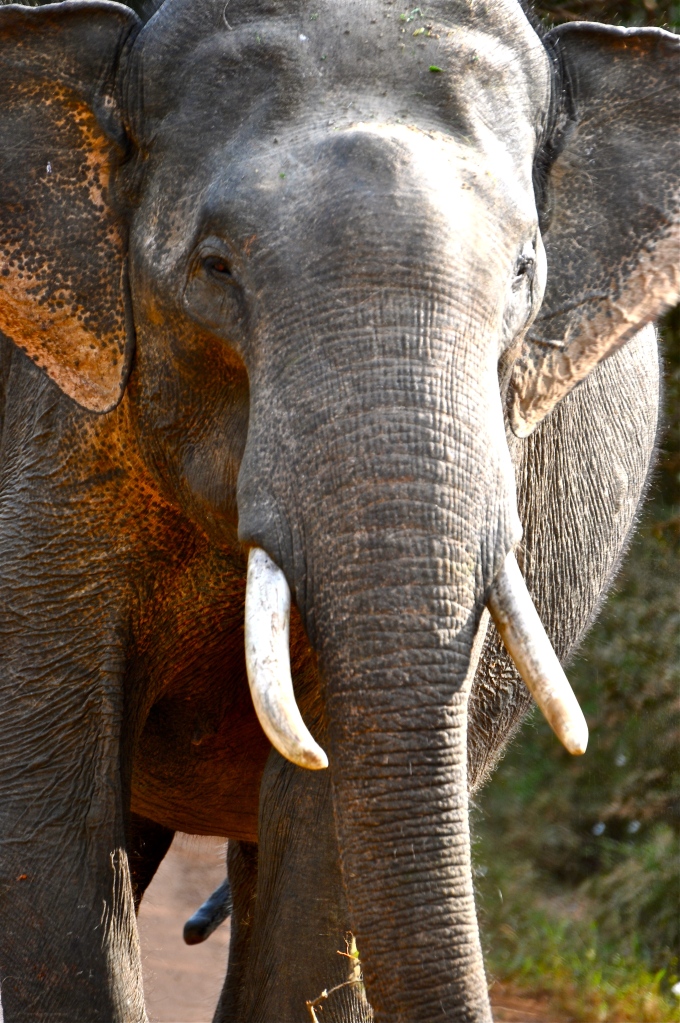
A second jeep arrived down the track, facing us but our elephant continued on, apathetic to its presence. An open top tractor chugged on to the scene, with three farmers, short cutting through the park to tend their fields. Clearly these locals were far from happy at the thought of a close encounter of the elephant kind, while they sat without the false comfort of a jeep roof. We watched them reverse back as the elephant plodded forward, until he decided it was time to muscle his way back in to the dense foliage.
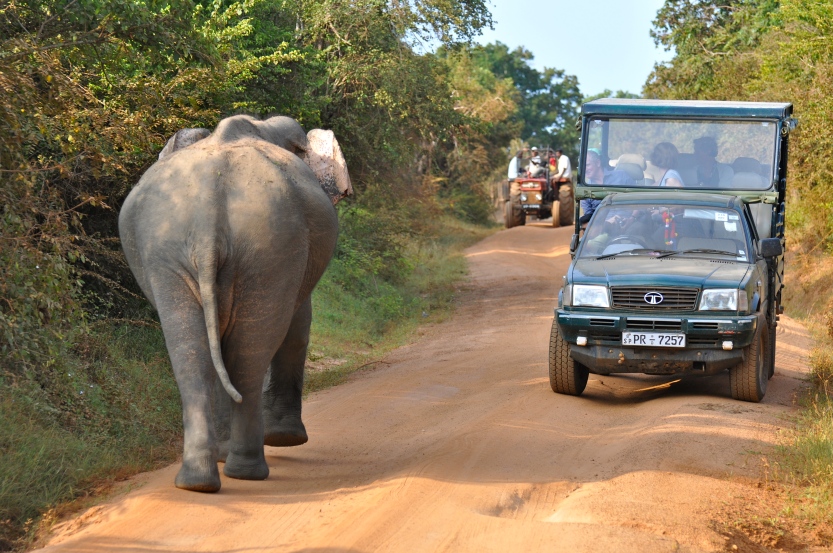
There are approximately 4,500 Sri Lankan elephants roaming wild on the island, around 300 of which populate Yala National Park. Like so many endangered species, the population continues to decline, largely because humans and elephants have not worked out how to co-exist. Competition for land, thirst for ivory and land mines from the days of civil war continue to erode the numbers of these wonderful animals.
Elephants are well protected in Sri Lanka, poachers or people defending their land face the death penalty for killing this culturally significant creature. This commitment to protection of the animal gives us hope for their future, but it is only by protecting large habitats such as Yala, that we can guarantee that priceless experiences like mine will be possible for generations to come.
If you enjoyed this post, please follow Incidental Naturalist.
Comments or feedback welcomed, below
Categories: Asia
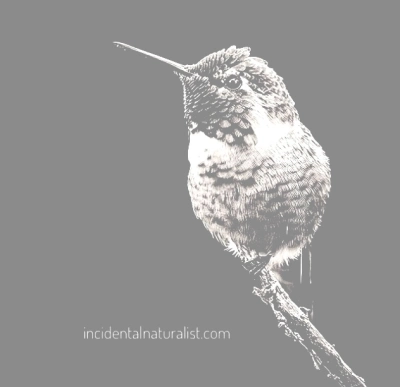


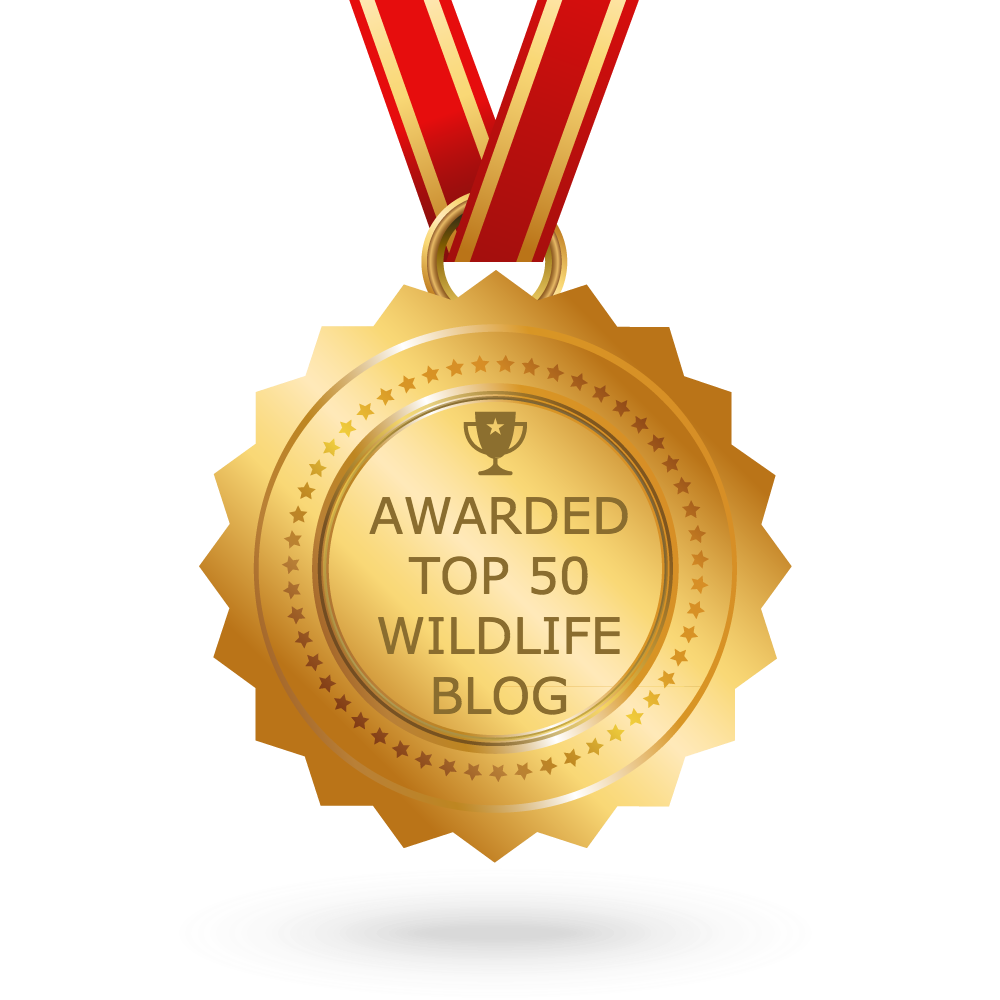

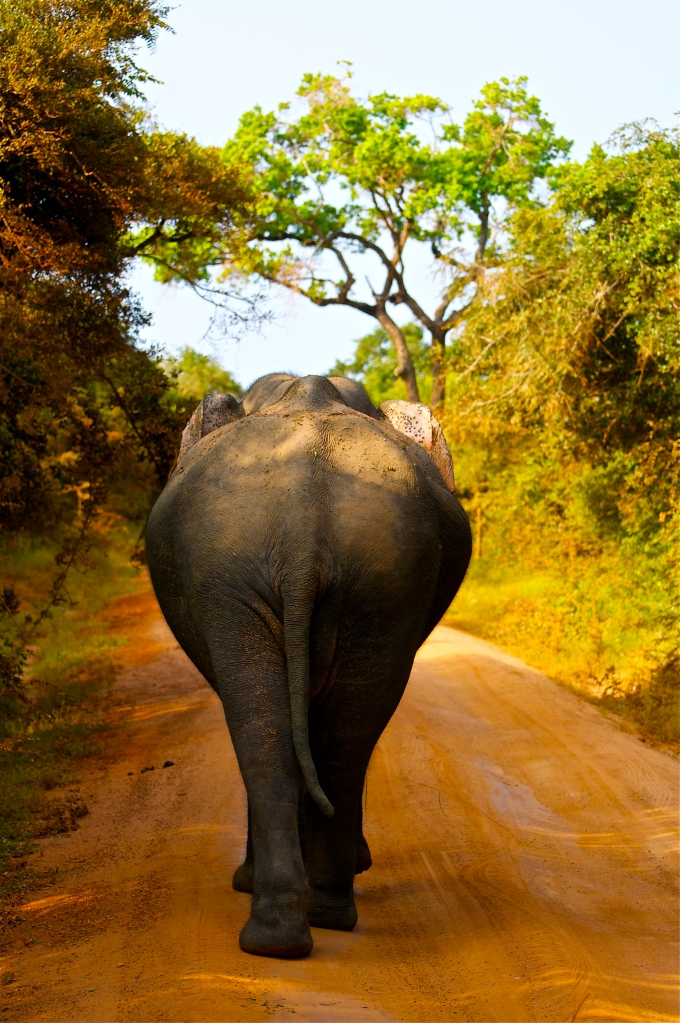
Stunning pictures of these majestic creatures and an interesting story of your adventures among them, as well. You are well blessed to be able to have such incredible experiences with the wildlife of the world and I feel blessed to be able to relive them in a second hand nature through your remarkable blog posts. Thank you for sharing!
LikeLiked by 1 person
Oh wow…beautiful pics as I re-live my visit to Yala! Thanks for bringing it to life for me again.
LikeLiked by 1 person
Enjoyed all of the elephant pictures, but quite partial to that parting shot. Well done!
LikeLike
Thanks! I have to say that I am partial to the parting shot, too.
LikeLike
David, a wonderful post! Thankyou for sharing your touching recount of those beautiful animals in Yala. Your writing is as descriptive as your photos, and I felt as though I was there every step of the way. An awesome pic for the finale, and a perspective not so often seen when capturing elephants in wildlife photography. Hopefully one day I will get the chance to see these beautiful beasts, but your photos have almost bought them to life for me, for now 🙂 Leah
LikeLiked by 2 people
Thanks for the kind comment, Leah! I have to say that I am quite taken by the last photo, too. We all seem to like his rear end! I guess it is the side we see least. 🙂
LikeLike
nice article & photos 🙂
in Indonesia there is an elephant sanctuary , Way Kambas National Park , Lampung province , southern Sumatra
LikeLiked by 1 person
Oh my goodness! What beautiful animals. Breaks my heart that these beautiful creatures are endangered. Glad to see some people working hard to save them.
LikeLiked by 1 person
Sri Lanka is a very special place for us. You wrote a beautiful tribute to the Island of Serendib and to her treasured elephants. Thank you David. Sharon
LikeLiked by 1 person
Great pictures and story. Love your last picture. Would use it as my Facebook profile photo if I could. What equipment did you use?
LikeLiked by 1 person
Thanks! The equipment is that special. I have a Nikon D90. I think he was so close that I just used the standard kit lens for this shot. The other lens I use is the 70 – 300mm which I hope to upgrade to a 400mm next month.
LikeLike
I’m so thrilled I stumbled on this, the photos are just lovely. I’m going to Sri Lanka in September and now I am beyond excited. Lovely post, thank you.
LikeLiked by 1 person
Thanks for the great comment! Sri Lanka is a great country. I can see by your blog that you are partial to a great meal. You will find some fantastic food in Sri Lanka.
LikeLike